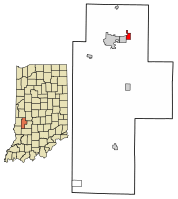Harmony, Indiana
Harmony is a town in Van Buren Township, Clay County, Indiana, United States. The population was 656 at the 2010 census. It is part of the Terre Haute Metropolitan Statistical Area.
- For the utopian settlement formerly known as Harmony, see New Harmony, Indiana
Harmony, Indiana | |
|---|---|
 Location of Harmony in Clay County, Indiana. | |
| Coordinates: 39°32′7″N 87°4′26″W | |
| Country | United States |
| State | Indiana |
| County | Clay |
| Township | Van Buren |
| Area | |
| • Total | 0.82 sq mi (2.13 km2) |
| • Land | 0.82 sq mi (2.13 km2) |
| • Water | 0.00 sq mi (0.00 km2) |
| Elevation | 719 ft (219 m) |
| Population | |
| • Total | 656 |
| • Estimate (2019)[3] | 641 |
| • Density | 779.81/sq mi (300.97/km2) |
| Time zone | UTC-5 (EST) |
| • Summer (DST) | UTC-5 (EST) |
| ZIP code | 47853 |
| Area code(s) | 812 |
| FIPS code | 18-31486[4] |
| GNIS feature ID | 0435746[5] |
History
Harmony was platted in 1864, although there had long been a small settlement at the site.[6]
Coal Company Store was listed on the National Register of Historic Places between 1986 and 1992.[7]
Geography
Harmony is located at 39°32′07″N 87°04′26″W.[8]
According to the 2010 census, Harmony has a total area of 0.74 square miles (1.92 km2), all land.[9]
Demographics
| Historical population | |||
|---|---|---|---|
| Census | Pop. | %± | |
| 1870 | 597 | — | |
| 1880 | 838 | 40.4% | |
| 1890 | 1,020 | 21.7% | |
| 1980 | 613 | — | |
| 1990 | 645 | 5.2% | |
| 2000 | 589 | −8.7% | |
| 2010 | 656 | 11.4% | |
| Est. 2019 | 641 | [3] | −2.3% |
| U.S. Decennial Census[10] | |||
2010 census
As of the census[2] of 2010, there were 656 people, 265 households, and 176 families living in the town. The population density was 874.7 inhabitants per square mile (337.7/km2). There were 292 housing units at an average density of 389.3 per square mile (150.3/km2). The racial makeup of the town was 97.6% White, 0.8% African American, 0.3% Asian, 0.9% from other races, and 0.5% from two or more races. Hispanic or Latino of any race were 1.2% of the population.
There were 265 households, of which 34.7% had children under the age of 18 living with them, 48.3% were married couples living together, 13.2% had a female householder with no husband present, 4.9% had a male householder with no wife present, and 33.6% were non-families. 30.2% of all households were made up of individuals, and 12.4% had someone living alone who was 65 years of age or older. The average household size was 2.48 and the average family size was 3.04.
The median age in the town was 38.6 years. 25.2% of residents were under the age of 18; 9.4% were between the ages of 18 and 24; 25% were from 25 to 44; 27% were from 45 to 64; and 13.6% were 65 years of age or older. The gender makeup of the town was 45.3% male and 54.7% female.
2000 census
According to the census[4] of 2000, there were 589 people, 241 households, and 160 families living in the town. The population density was 781.0 people per square mile (303.2/km2). There were 255 housing units at an average density of 338.1 per square mile (131.3/km2). The racial makeup of the town was 97.62% White, 0.17% African American, 0.34% Asian, 0.51% from other races, and 1.36% from two or more races.
There were 241 households, out of which 34.4% had children under the age of 18 living with them, 52.3% were married couples living together, 11.2% had a female householder with no husband present, and 33.6% were non-families. 27.8% of all households were made up of individuals, and 10.8% had someone living alone who was 65 years of age or older. The average household size was 2.44 and the average family size was 2.99.
In the town, the population was spread out, with 28.2% under the age of 18, 8.3% from 18 to 24, 27.8% from 25 to 44, 22.1% from 45 to 64, and 13.6% who were 65 years of age or older. The median age was 35 years. For every 100 females, there were 82.9 males. For every 100 females age 18 and over, there were 83.1 males.
The median income for a household in the town was $33,438, and the median income for a family was $41,750. Males had a median income of $31,406 versus $21,333 for females. The per capita income for the town was $16,276. About 7.2% of families and 8.2% of the population were below the poverty line, including 12.2% of those under age 18 and 8.0% of those age 65 or over.
References
- "2019 U.S. Gazetteer Files". United States Census Bureau. Retrieved July 16, 2020.
- "U.S. Census website". United States Census Bureau. Retrieved 2012-12-11.
- "Population and Housing Unit Estimates". United States Census Bureau. May 24, 2020. Retrieved May 27, 2020.
- "U.S. Census website". United States Census Bureau. Retrieved 2008-01-31.
- "US Board on Geographic Names". United States Geological Survey. 2007-10-25. Retrieved 2008-01-31.
- Blanchard, Charles (1884). Counties of Clay and Owen, Indiana: Historical and Biographical. F.A. Battey & Company. pp. 242.
- "National Register Information System". National Register of Historic Places. National Park Service. July 9, 2010.
- "US Gazetteer files: 2010, 2000, and 1990". United States Census Bureau. 2011-02-12. Retrieved 2011-04-23.
- "G001 - Geographic Identifiers - 2010 Census Summary File 1". United States Census Bureau. Archived from the original on 2020-02-13. Retrieved 2015-07-17.
- "Census of Population and Housing". Census.gov. Retrieved June 4, 2015.